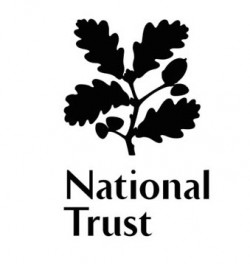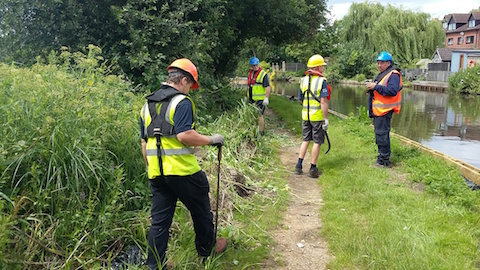 Abraham Lincoln
If given the truth, the people can be depended upon to meet any national crisis...
Abraham Lincoln
If given the truth, the people can be depended upon to meet any national crisis...
 Guildford news...
for Guildford people, brought to you by Guildford reporters - Guildford's own news service
Guildford news...
for Guildford people, brought to you by Guildford reporters - Guildford's own news service
Richard’s Wey July 2016
Published on: 17 Jul, 2016
Updated on: 17 Jul, 2016
 The latest report from Richard Cant, the Stoke lengthman on the River Wey Navigations
The latest report from Richard Cant, the Stoke lengthman on the River Wey Navigations
The theme for June was sunshine and showers which created perfect growing conditions for all the vegetation, but not so perfect boating weather.
This meant that I was busy not only mowing the locksides but also cutting back the towpath vegetation.
It involved strimming the banks at a 45 degree angle to keep the vegetation clear of the path but maintaining habitat, and also lightly hedge trimming the back of the towpath to stop encroaching shrubs and brambles whilst being careful not to disturb nesting birds.
A big thank you to my volunteers for helping with this job, as it meant they could warn me of any oncoming walkers or cyclists and keep the path clear of cut brambles and thorns, something which I’m sure all the cyclists will appreciate.
The fishing season re-opened on June 16, so in preparation for this I have been cutting fishing swims into the bankside vegetation in places that I know fishermen enjoy using, but also that don’t hinder other river and towpath users.
If you are interested in fishing on the Wey Navigation you will need an Environment Agency Rod Licence and either a day or season ticket from Guildford Angling Society.
Please remember to take any litter or fishing tackle home with you as this can pose a real hazard to wildlife, as well as spoiling other people’s enjoyment of the river.
The other big job has been to start the annual control of the plant Himalayan balsam.
This fast growing plant with a pretty pink flower is a non-native invasive species that will out-compete our own native plants, taking over areas and reducing biodiversity.
The best means of controlling it is pulling each stem by hand, which is labour intensive but can be effective if done each year.
This is why I spent a day with the Wey Navigation Conservation Volunteers in Shalford nature reserve for a session of mass balsam pulling.
We have visited this site previously so although the task was somewhat arduous, it was also very satisfying to see the difference we were making.
Back on my own length and the Himalayan balsam also needed controlling, this time in smaller quantities but on the closed section of towpath between Ladymead and the A320 that is currently being restored by Land & Water.
The concern here was that if we didn’t clear the site of balsam it could go to seed and be spread by the excavation work.

NT staff and volunteers in full protective clothing to help prevent Himalayan balsam being spread during towpath restoration work.
A simple problem to solve with a small group of volunteers, until you realise that as the area is a working construction site we needed to be fully equipped in hard hats, hi-vis and life jackets and then inducted in site safety before being allowed to even step foot on the towpath.
Thankfully the Land & Water staff were very accommodating and even explained to my volunteers what they were doing and how, making it a very interesting day for everyone.
Richard
Stoke Lengthsman
07786 703 832

See Dragon story: GBC’s Explanation of Major Land Sale Notice Error ‘Borders on Arrogant’ Says Councillor







Recent Articles
- City and Manager ‘Part Company’ After Slide in Results
- PCC Election Result – Conservative Lisa Townsend Retains Commissioner Role
- Letter: It’s a Sad State of Affairs
- Times Rankings Showing GBC To Be Worst Council in Surrey Dismissed by Lib Dems
- Birdwatcher’s Diary No.303
- Letter: What a Scoop!
- Filmfest – a Festival of German Films
- Letter: Help Abroad Should Not Be to the Detriment of Those Here
- Armed Police Deployed After Fight at Ash Vale Pub – Four Arrested
- Surrey Schools Could Have ‘Meat-free Mondays’ If Strategy Adopted


Search in Site
Media Gallery
Dragon Interview: Local Artist Leaves Her Mark At One of England’s Most Historic Buildings
January 21, 2023 / No Comment / Read MoreDragon Interview: Lib Dem Planning Chair: ‘Current Policy Doesn’t Work for Local People’
January 19, 2023 / No Comment / Read MoreA3 Tunnel in Guildford ‘Necessary’ for New Homes, Says Guildford’s MP
January 10, 2023 / No Comment / Read More‘Madness’ for London Road Scheme to Go Ahead Against ‘Huge Opposition’, Says SCC Leader
January 6, 2023 / No Comment / Read MoreCouncillor’s Son Starts Campaign for More Consultation on North Street Plan
December 30, 2022 / No Comment / Read MoreCounty Council Climbs Down Over London Road Works – Further ‘Engagement’ Period Announced
December 14, 2022 / No Comment / Read MoreDragon Interview: GBC Reaction to the Government’s Expected Decision to Relax Housing Targets
December 7, 2022 / No Comment / Read MoreHow Can Our Town Centre Businesses Recover? Watch the Shop Front Debate
May 18, 2020 / No Comment / Read More






Recent Comments